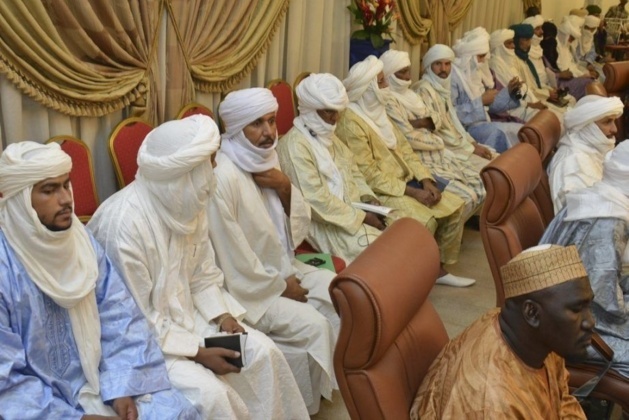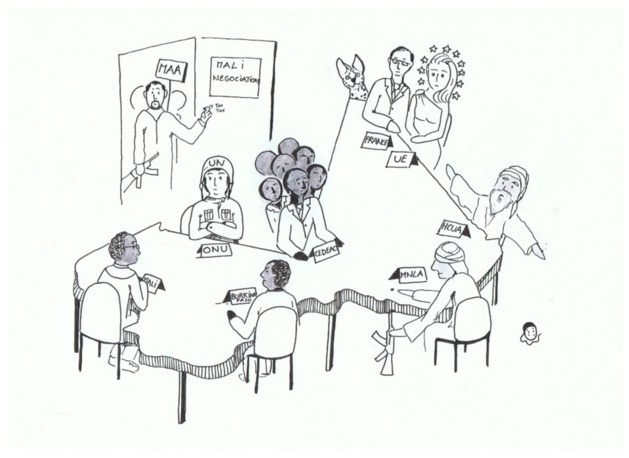
Ahmed Ouoba / AFP
The Malian presidential elections have finally been set for July 28. The main objective can’t be clearer: ensure Mali’s political stability. Indeed, since April 2012 and the coup d’Etat of Captain Amadou Sanogo, the country is ruled by a temporary president, Dioncounda Traoré. The election will also be a way to solve legitimately the thorny issue of Northern Mali where most of the fights occurred over the last few months. However, for the election to be legitimised, it must be organised impartially in the whole country. And yet, the region of Kidal is still controlled by the MNLA (National Movement for the Liberation of Azawad).
Therefore, the opening of negotiations between the Malian government and the armed Tuareg tribes of Kidal was essential. Negotiations were organized from June 8 in Ouagadougou (Burkina Faso) under the mediation of Burkinabe president Blaise Compaoré (the Economic Community Of West African States - ECOWAS mediator) and under surveillance of the international community. Bamako’s emissary, Tiébilé Dramé, was sent to chair the negotiations. On the other side, a new partner appeared: the High Council for the Azawad (HCA) whose ambition is to unite the various liberation movements. The HCA favours the organisation of elections in July.
The Amenokal Intallah ag Ataher, patriarch and traditional chieftain of the Ifoghas Tuareg community, leads the HCA. The High Council already managed to unite the Islamic Movement of Azawad (MIA) – created in late January from a division of Ansar Dine and now dissolved - and the Popular Front of the Azawad (FPA). The other main negotiator, the National Movement for the Liberation of Azawad (MNLA), did not join the HCA but still accepted to join the negotiations.
All parties seem to accept the fact that elections must be organised but procedures are still being discussed.
Therefore, the opening of negotiations between the Malian government and the armed Tuareg tribes of Kidal was essential. Negotiations were organized from June 8 in Ouagadougou (Burkina Faso) under the mediation of Burkinabe president Blaise Compaoré (the Economic Community Of West African States - ECOWAS mediator) and under surveillance of the international community. Bamako’s emissary, Tiébilé Dramé, was sent to chair the negotiations. On the other side, a new partner appeared: the High Council for the Azawad (HCA) whose ambition is to unite the various liberation movements. The HCA favours the organisation of elections in July.
The Amenokal Intallah ag Ataher, patriarch and traditional chieftain of the Ifoghas Tuareg community, leads the HCA. The High Council already managed to unite the Islamic Movement of Azawad (MIA) – created in late January from a division of Ansar Dine and now dissolved - and the Popular Front of the Azawad (FPA). The other main negotiator, the National Movement for the Liberation of Azawad (MNLA), did not join the HCA but still accepted to join the negotiations.
All parties seem to accept the fact that elections must be organised but procedures are still being discussed.
Take Kidal back

© Pierrot
The talks that are taking place since Saturday June 8 aim at the signature of an agreement which must cover essential issues. Firstly, the fights must end – a non-negotiable point – and there shall be guarantees that negotiations will continue after the elections in order to secure a long-term peace. Secondly, both the civil service and the military must join Kidal to ensure that the elections occur in a secured environment.
This last point is strongly discussed. It seems that the armed Tuareg tribes refuse to hand over the control of the city to the Malian government. They fear that the military will threaten them as well as the population. And this fear is legitimate: at the beginning of June, Amnesty International published a preliminary report listing all exactions committed in Mali by armed groups, including the Malian army. Some of these exactions fall into the category of war crimes. Meanwhile, on June 5th, sporadic fights occurred between the Malian army and MNLA troops in the village of Anéfis located a hundred kilometres south of Kidal. So far controlled by the MNLA, the village has now been retaken by the military. Another example of how much mistrust reigns between the negotiators.
On Monday the 10th, the first solutions proposed included a control of the Malian army in Kidal by the Minusma, the UN’s future military force now leaded by Rwandan General Jean-Bosco Kazura. This force should then absorb the pan-African force, the Misma. The constitution of a mixed force with units from the Malian army and the MNLA has also been discussed.
This last point is strongly discussed. It seems that the armed Tuareg tribes refuse to hand over the control of the city to the Malian government. They fear that the military will threaten them as well as the population. And this fear is legitimate: at the beginning of June, Amnesty International published a preliminary report listing all exactions committed in Mali by armed groups, including the Malian army. Some of these exactions fall into the category of war crimes. Meanwhile, on June 5th, sporadic fights occurred between the Malian army and MNLA troops in the village of Anéfis located a hundred kilometres south of Kidal. So far controlled by the MNLA, the village has now been retaken by the military. Another example of how much mistrust reigns between the negotiators.
On Monday the 10th, the first solutions proposed included a control of the Malian army in Kidal by the Minusma, the UN’s future military force now leaded by Rwandan General Jean-Bosco Kazura. This force should then absorb the pan-African force, the Misma. The constitution of a mixed force with units from the Malian army and the MNLA has also been discussed.
Bamako’s exigencies
The Malian government seeks to include as many movements as possible in the negotiating process, so the legitimacy of the elections cannot be contested. Tiébilé Dramé, the president’s special advisor, is trying to include two other armed groups - the Arab Movement of Azawad (MAA) and the auto-defence militia Ganda Koy - to the negotiation rounds. But the HCA and the MNLA reject the attendance of these two groups around the negotiation table and so far very little contact has been established. This deadlock illustrates the difficulties originating from an important ethnic and ideological diversity in Mali, especially in the northern part of the country.
Bamako does not want the term “Azawad” - by which Tuareg tribes refer to the three regions of Kidal, Tombouctou and Gao - to appear in the final agreement. A sign that independence claims, which have been silenced so far, might re-emerge.
Bamako does not want the term “Azawad” - by which Tuareg tribes refer to the three regions of Kidal, Tombouctou and Gao - to appear in the final agreement. A sign that independence claims, which have been silenced so far, might re-emerge.
Towards a quick agreement
On June the 10th, despite the divergent opinions, the parties agreed in principle to put an end to the fighting and to redeploy (under surveillance and control) the Malian civil service in Kidal. Tiébilé Dramé went back to Bamako to present the first conclusions of the negotiations to the government. On their side, the MNLA and the HCA have to present the preliminary agreement to their troops. A pacific settlement of the Malian issue seems under way but troubles could reappear after the elections.
At the same time, the temporary government has to deal with the hundreds of thousands of Malian refugees who fled the fights and who are now wondering whether they will be able to vote and in what conditions. Time is running out, as the election is scheduled to be organised in less than two months.
At the same time, the temporary government has to deal with the hundreds of thousands of Malian refugees who fled the fights and who are now wondering whether they will be able to vote and in what conditions. Time is running out, as the election is scheduled to be organised in less than two months.



























